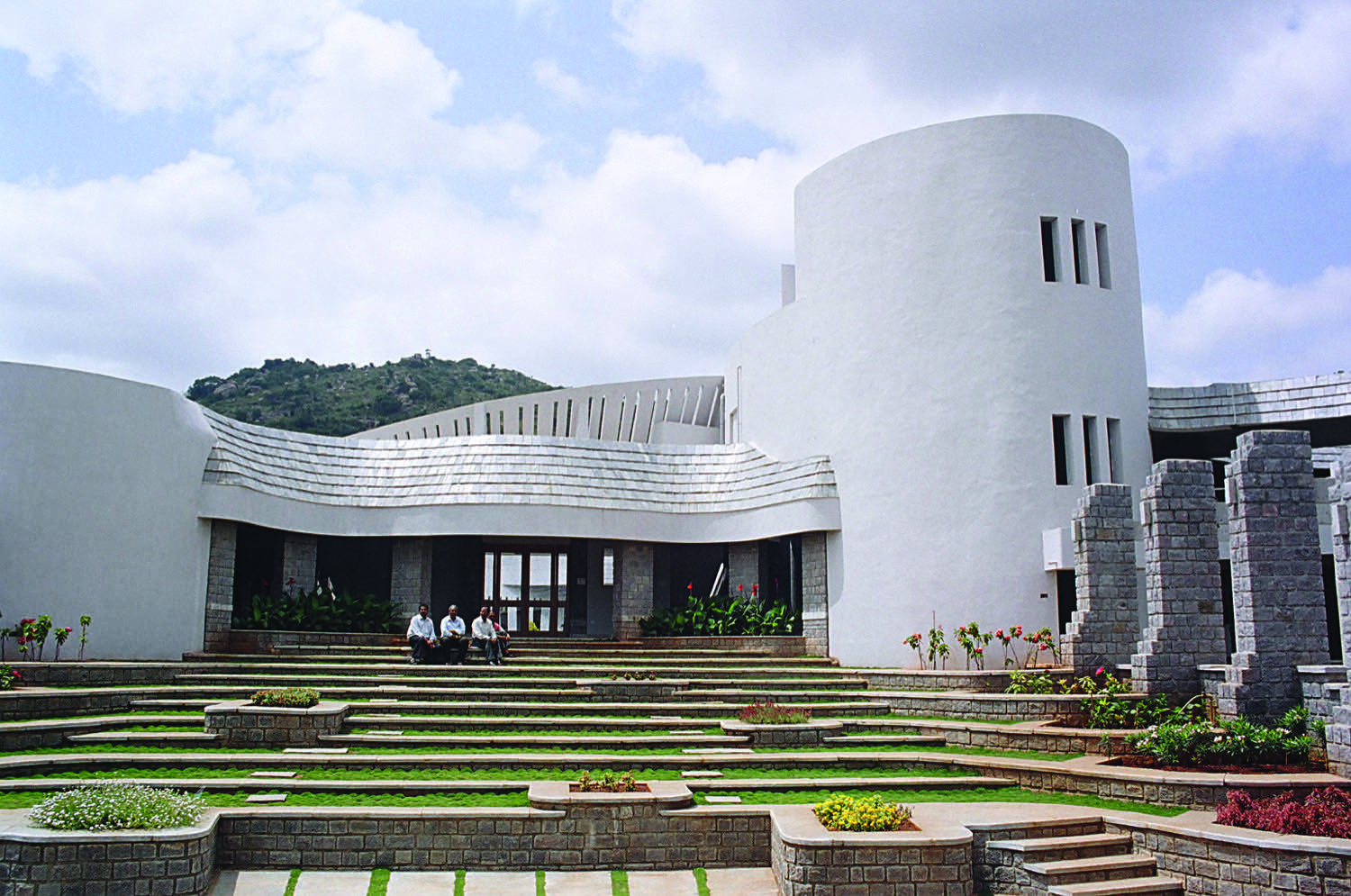
“We would like our management institute to be rooted in Indian values and not be a copy of the typical western model” – spoke Shri Heggadeji (the president of Shri Dharamsthala Manjunatheshwara Trust) about his vision for this institute’s 13-acre campus in Mysore.
Interaction being the crux of management education, I felt that every space needs to be designed to encourage interaction that would further facilitate meaningful learning. The issue was to connect each student to Nature and to other students and faculty (as in the early gurukuls) in such a way that this connection enhanced the learning process effectively. The sloping, undulating site was located at the base of the beautiful Chamundi Hill, with a narrow driveway access from the main road. I designed the building to flow with the contours and thereby create a hierarchy of spaces with the intermingling of natural landscaped areas with the built ones.
I felt that learning should also happen outside the classrooms as well as inside them. Besides being vibrant, useful contributors to the overall learning process, these intermittent landscaped natural spaces create a contemporary Indian ethos with the handcrafted stone form and a sustainable environment with lots of greenery, recycled resources and use of solar energy. They also bind and unify the diverse activities together with their transparency. This further improves the communication potential on the campus. In the plan, there appear three functional zones (each with its own landscaped focus), which are merged together by transparent transitional spaces, interconnecting passages and green courtyards.
In the first zone, I have created an arrival court, a pause (like an angan) from where one can either go to the administrative area or to the auditorium or to the amphitheatre and classrooms. The second zone has the smaller green courtyard with classrooms and faculty rooms around it. The third one has the lowest level interactive courtyard with a cafeteria, a library and a yoga or exhibition hall around it. Entry into this main building from the hostels is possible through this zone itself. Thus, several opportunities are created for effective interaction. The arrival space is one such space where chance meetings are never scarce.
The green amphitheatre is suitable for cultural events, lectures, group photo sessions, yoga, meditation and small group chats. We find students standing and chatting in the shaded, cool passage under the creeper-covered pergola while some sit on its stone stepped edges. The general corridors too have been purposefully widened at corners to accommodate built-in seating for discussions. Specially designed seating arrangements pepper the garden outside the administration area and other spaces.
The whole building maintains a very human scale with the heights varying from single storey to ground plus two storeys. This place also exudes a certain warmth because of the use of natural materials/elements in its architectural vocabulary. The natural materials used here are maintenance-free and hence the building looks fresh and contemporary even after many years, without appearing dirty, boring and monotonous. Local stone is used for masonry, Sira stone for the amphitheatre’s steps and copings and native Chinkurli rough granite for pergola columns and beams. Slate stone is used for roof and parapet cladding.
Only the entrance court walls have glass mosaic. Almost all the spaces enjoy natural lighting and ventilation. Artificial illumination during daytime and air conditioning are avoided. The sewage treatment plant provides ample recycled water for gardening. Solar water heaters are also installed over the hostels. The overall cost of this building was almost half the cost of a similar facility in the same city built at around the same time. The spaces in this building have a kinaesthetic quality, because of which they eloquently unfold varied rejuvenating experiences for the users. There are spatial surprises around corners as one moves within this building. They are very different from what one experiences on the outside. This is what most visitors enjoy and relish.
Dr. Heggadeji remarked, ‘The students in particular enjoy the ambience and the serene atmosphere. One of the students felt he was in an old house with a Chowki quadrangle. Students come out of the classroom to find themselves in a beautiful garden with an Open Air Theatre. On the whole, the ‘peace of mind’ providing ambience of the campus – a tension free zone is conducive to the education of students. When faculty and students from eight countries visited this campus for an event, they were so much enamoured that they decided to use the arrival court slits to frame them for a memento group picture. To the students and faculty, this building and its symbiotic landscaped spaces have become informal, open, natural environments which are quite enjoyable besides being conducive to interactive management studies.
















